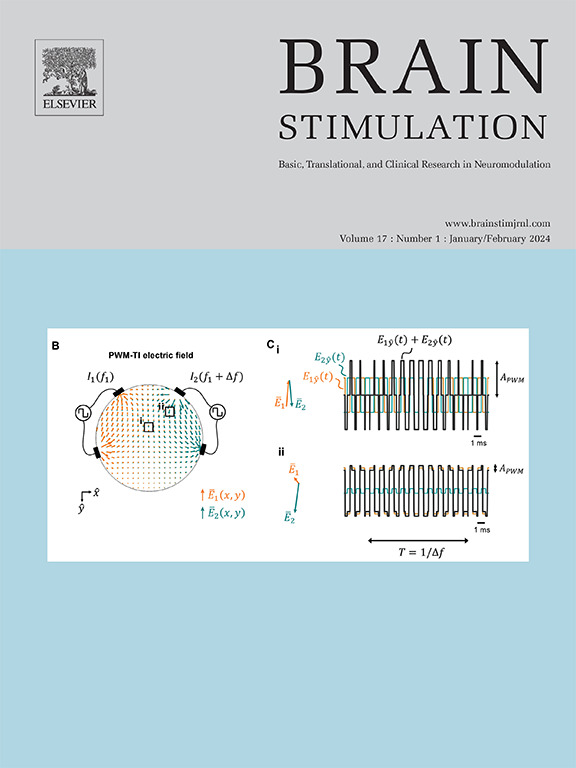与年轻人相比,健康老年人对经颅直流电刺激的反应变异性增加:一项系统回顾和荟萃分析
IF 8.4
1区 医学
Q1 CLINICAL NEUROLOGY
引用次数: 0
摘要
背景:健康老龄化与认知和运动功能下降有关,影响日常活动和生活质量。结合经颅直流电刺激(tDCS)与行为训练可能是一个有希望的干预这种下降。然而,个体反应的可变性可能会模糊群体水平的效果,并误导关于tDCS疗效的结论。量化这种可变性对于准确评估刺激效果和理解个体反应因素(如年龄)至关重要。然而,目前还没有研究对不同年龄组的tDCS变异性进行定量比较。本系统综述和荟萃分析研究了tDCS的认知和运动反应的年龄相关变异性。方法:根据PRISMA指南,我们检索PubMed和Cochrane,在相似的实验条件下直接比较年轻和健康老年人的研究。在接受经颅直流电(tDCS)治疗的390名老年人(平均±SD年龄:67±5岁)和384名年轻人(平均±SD年龄:24±3岁)的19项研究中,我们使用对数变换变异比系数(lnCVR)量化了行为变异性。结果:结果显示,与年轻人相比,健康老年人在活动tES期间的反应变异性明显更高(21%,lnCVRactive = -0.24 [-0.43, -0.04], p = 0.02),但在假手术条件下则不然(lnCVRsham = -0.18 [-0.42, 0.05], p = 0.13)。结论:这些发现提供了第一个量化证据,表明年龄增长会增加行为tDCS反应的可变性,强调了开发个性化tDCS方法以优化其在老年人中的疗效的必要性。本文章由计算机程序翻译,如有差异,请以英文原文为准。
Increased variability in response to transcranial direct current stimulation in healthy older compared to young adults: A systematic review and meta-analysis
Background
Healthy aging is associated with a decline in cognitive and motor functions, affecting daily activities and quality of life. Combining transcranial direct current stimulation (tDCS) with behavioral training may be a promising intervention against this decline. However, individual response variability may obscure group-level effects and mislead conclusions about tDCS efficacy. Quantifying this variability is crucial for accurately assessing stimulation effects and understanding individual response factors, like age. Yet, no study has quantitatively compared tDCS variability across age groups. This systematic review and meta-analysis examine age-related variability in cognitive and motor responses to tDCS.
Methods
Following PRISMA guidelines, we searched PubMed and Cochrane for studies directly comparing young and healthy older adults under similar experimental conditions. Across 19 studies comprising 390 older adults (mean ± SD age: 67 ± 5 years) and 384 young adults (mean ± SD age: 24 ± 3 years) receiving transcranial direct current (tDCS), we quantified behavioral variability using the log-transformed coefficient of variation ratio (lnCVR).
Results
Results revealed substantially higher response variability in healthy older compared to young adults during active tES (21 %, lnCVRactive = −0.24 [-0.43, −0.04], p = 0.02), but not during sham conditions (lnCVRsham = −0.18 [-0.42, 0.05], p = 0.13).
Conclusion
These findings provide the first quantitative evidence that advanced age increases behavioral tDCS response variability, highlighting the need to develop personalized tDCS approaches to optimize their efficacy in older populations.
求助全文
通过发布文献求助,成功后即可免费获取论文全文。
去求助
来源期刊

Brain Stimulation
医学-临床神经学
CiteScore
13.10
自引率
9.10%
发文量
256
审稿时长
72 days
期刊介绍:
Brain Stimulation publishes on the entire field of brain stimulation, including noninvasive and invasive techniques and technologies that alter brain function through the use of electrical, magnetic, radiowave, or focally targeted pharmacologic stimulation.
Brain Stimulation aims to be the premier journal for publication of original research in the field of neuromodulation. The journal includes: a) Original articles; b) Short Communications; c) Invited and original reviews; d) Technology and methodological perspectives (reviews of new devices, description of new methods, etc.); and e) Letters to the Editor. Special issues of the journal will be considered based on scientific merit.
 求助内容:
求助内容: 应助结果提醒方式:
应助结果提醒方式:


